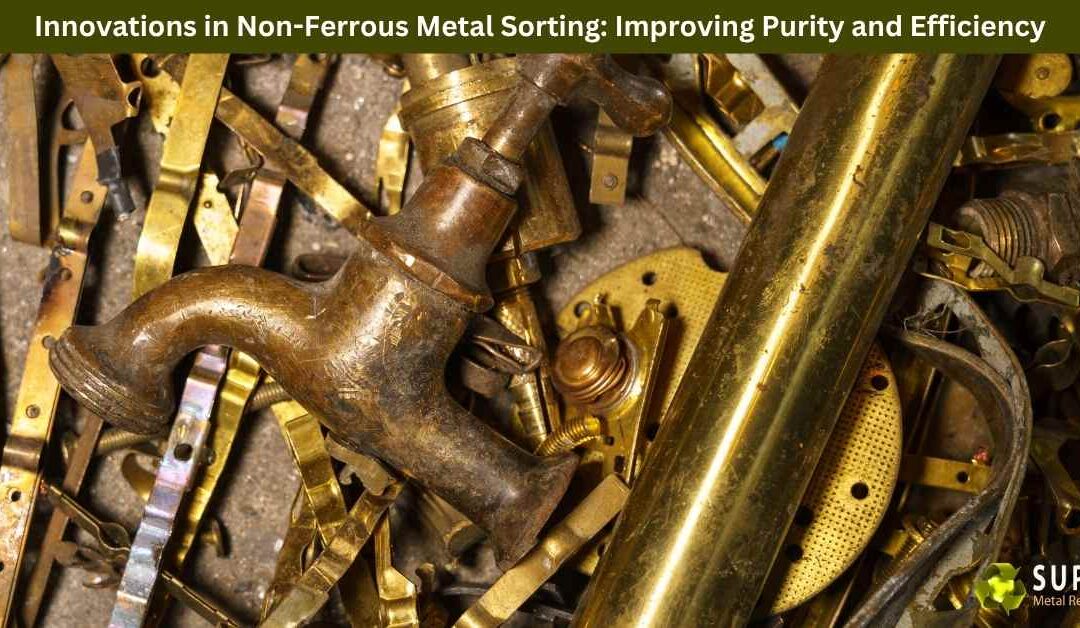In the fast-moving world of metal recycling, technology is playing a bigger role than ever before. And when it comes to non-ferrous metals—like aluminum, copper, brass, and stainless steel—the need for smarter, more accurate sorting methods is only growing.
Why? Because non-ferrous metals are valuable, but they’re often mixed together in scrap loads. Sorting them properly means better-quality recycled materials, higher resale value, and less waste. The good news? New innovations are making it easier (and faster) to sort non-ferrous metals with incredible precision.
Let’s take a closer look at what’s changing—and why it matters.
Why Sorting Non-Ferrous Metals Is a Big Deal
First off, let’s define the term: non-ferrous metals are metals that don’t contain iron. Unlike steel or cast iron (which are ferrous), non-ferrous metals don’t rust, they’re often lighter, and many have high conductivity or corrosion resistance. This makes them essential in everything from electronics to construction to renewable energy tech.
But here’s the challenge—when scrap metal comes in, it doesn’t arrive neatly separated. You might have aluminum siding, copper wiring, brass fittings, and stainless steel kitchenware all jumbled together. Manually sorting them is time-consuming, inconsistent, and inefficient.
That’s where innovation steps in.
Tech That’s Changing the Game
1. Eddy Current Separators
If there’s one piece of equipment that’s become a staple in modern recycling yards, it’s the eddy current separator. This tech uses a powerful magnetic field to separate non-ferrous metals from other materials—like plastics or steel.
When mixed scrap moves along a conveyor, the separator repels non-ferrous metals and throws them into a separate bin. It’s fast, efficient, and works well for materials like aluminum and copper.
2. Sensor-Based Sorting
This is where things get really advanced.
Modern sorting systems now use sensors—like near-infrared (NIR), X-ray transmission (XRT), and even laser-induced breakdown spectroscopy (LIBS)—to detect the exact type of metal based on its unique properties.
So instead of just sorting “metal from non-metal,” these systems can sort aluminum from zinc, or copper from brass, with remarkable accuracy. This means higher purity, which leads to better prices and more reliable end-products.
3. Robotic Arms & AI
Yes, even robots are joining the recycling revolution.
AI-powered robotic arms can now identify, pick, and sort metals with machine-learning algorithms. They scan each item using real-time cameras and sensors, then decide where it goes. These systems are especially helpful in small or mixed waste streams, where traditional machines might struggle.
Not only does this reduce labour needs, but it also keeps workers safer by minimizing direct contact with sharp or contaminated materials.
Real-World Impact: Better Results, Less Waste
Here’s a practical example. A mid-size recycling facility in Victoria recently upgraded its sorting line to include sensor-based sorters and eddy current systems. Before the upgrade, their sorted aluminum loads contained around 88–90% purity. After automation and smart sorting? That jumped to over 98%.
This kind of precision isn’t just good for quality control—it means fewer rejected loads, better deals with metal buyers, and less contamination in the recycling stream.
The Efficiency Bonus
Improved sorting doesn’t just raise purity—it also boosts processing speed. What used to take hours or days of manual sorting can now be done in a fraction of the time. And since machines don’t get tired or distracted, the quality stays consistent from morning to night.
For metal recyclers, that’s a win-win: more material sorted in less time, with better results.
The Road Ahead
The push toward smarter non-ferrous sorting is only just beginning. As AI improves, and sensor tech gets more affordable, we can expect even more precise and flexible sorting systems in the near future.
And as regulations tighten around waste and recycling, especially in countries like Australia, investing in better sorting technology isn’t just a smart move—it’s becoming essential.
Just Something to Think About
The days of basic scrap sorting are behind us. In today’s recycling world, precision matters—and innovations in non-ferrous metal sorting are helping recyclers stay ahead. By improving purity and speeding up the process, these technologies are turning yesterday’s scrap into tomorrow’s resource, more efficiently than ever.
If you are in Cranbourne, and looking for a metal recycling service, this is the best way to visit us.
Super Metal Recycling
345 Frankston – Dandenong Road, Dandenong South VIC 3175
(03) 9706 4909


Recent Comments